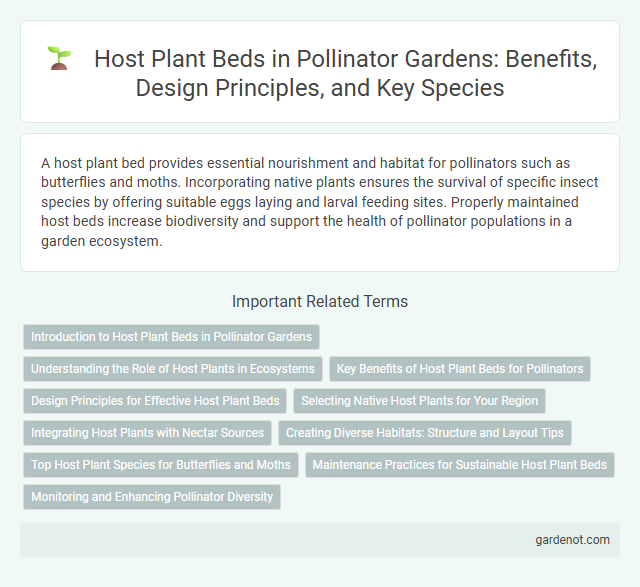A host plant bed provides essential nourishment and habitat for pollinators such as butterflies and moths. Incorporating native plants ensures the survival of specific insect species by offering suitable eggs laying and larval feeding sites. Properly maintained host beds increase biodiversity and support the health of pollinator populations in a garden ecosystem.
Introduction to Host Plant Beds in Pollinator Gardens
Host plant beds serve as essential habitats in pollinator gardens by providing specific plants where pollinators such as butterflies and bees lay their eggs and caterpillars feed. Incorporating native plants like milkweed, goldenrod, and coneflowers supports the life cycles of key pollinator species and enhances biodiversity. Designing these beds with diverse host plants promotes pollination efficiency and sustains local ecosystems.
Understanding the Role of Host Plants in Ecosystems
Host plants serve as essential habitats for pollinators, providing necessary food and shelter for larvae and adult insects. By supporting the life cycles of butterflies, bees, and other pollinators, host plant beds promote biodiversity and maintain ecological balance. Integrating native host plants into pollinator gardens enhances ecosystem resilience and supports native wildlife populations.
Key Benefits of Host Plant Beds for Pollinators
Host plant beds provide essential nourishment and habitat for pollinators by supplying the specific leaves and flowers required for larval development and adult feeding. These beds enhance biodiversity by supporting native pollinator species, including butterflies, bees, and moths, which rely on host plants for survival and reproduction. Establishing diverse host plant beds promotes healthier pollinator populations and improves pollination success for surrounding ecosystems.
Design Principles for Effective Host Plant Beds
Design principles for effective host plant beds prioritize plant diversity, incorporating native species that support local pollinators throughout their life cycles. Arranging plants in clusters with varied bloom times ensures continuous nourishment and habitat for caterpillars and adult pollinators. Soil quality, sun exposure, and water availability are critical factors, alongside avoiding pesticides to create a thriving ecosystem for pollinator species.
Selecting Native Host Plants for Your Region
Selecting native host plants for your region ensures pollinators have access to essential food and habitat resources tailored to their life cycles. Native plants like milkweed in the Midwest or lupine on the West Coast support specific butterfly and moth species, improving their survival rates. Incorporating region-specific host plants enhances biodiversity and strengthens local pollinator populations effectively.
Integrating Host Plants with Nectar Sources
Host plant beds strategically combine host plants with nearby nectar sources to support both pollinator larvae and adult insects, enhancing biodiversity and garden productivity. Selecting native host plants like milkweed or fennel alongside nectar-rich flowers such as coneflowers or bee balm creates continuous food availability throughout pollinators' life cycles. This integrated planting approach maximizes habitat suitability, promotes pollinator health, and increases successful pollination rates in the garden ecosystem.
Creating Diverse Habitats: Structure and Layout Tips
Designing a host plant bed with varied plant heights and species supports a wide range of pollinators by providing essential food and shelter. Incorporate native flowering plants, shrubs, and grasses arranged in layers to mimic natural ecosystems, enhancing biodiversity and habitat complexity. Strategic placement near water sources and open sunny areas maximizes pollinator activity and habitat sustainability.
Top Host Plant Species for Butterflies and Moths
Top host plant species for butterflies and moths in a pollinator garden include milkweed (Asclepias spp.), essential for monarch butterflies, and oak trees (Quercus spp.), which support numerous moth larvae. Butterfly bush (Buddleja davidii) attracts a wide variety of pollinators while serving as both nectar and host plants. Incorporating native plants such as goldenrod (Solidago spp.) and violet (Viola spp.) enhances habitat diversity and supports caterpillar development for many butterfly and moth species.
Maintenance Practices for Sustainable Host Plant Beds
Effective maintenance practices for sustainable host plant beds include regular pruning to promote healthy growth and prevent disease, mulching to conserve moisture and suppress weeds, and monitoring soil health to ensure optimal nutrient levels. Incorporating native plant species enhances biodiversity and supports local pollinators such as bees, butterflies, and hummingbirds. Avoiding chemical pesticides and fertilizers preserves beneficial insects and maintains ecological balance within the pollinator garden ecosystem.
Monitoring and Enhancing Pollinator Diversity
Regular monitoring of host plant beds through systematic surveys and data collection enables the identification of pollinator species diversity and activity patterns. Enhancing pollinator diversity involves planting a variety of native host plants that provide nectar and pollen resources throughout different blooming seasons, supporting multiple pollinator species. Incorporating habitat features such as shelter, water sources, and pesticide-free zones further promotes a thriving pollinator community within the garden ecosystem.
Host plant bed Infographic

 gardenot.com
gardenot.com